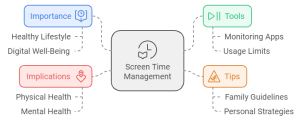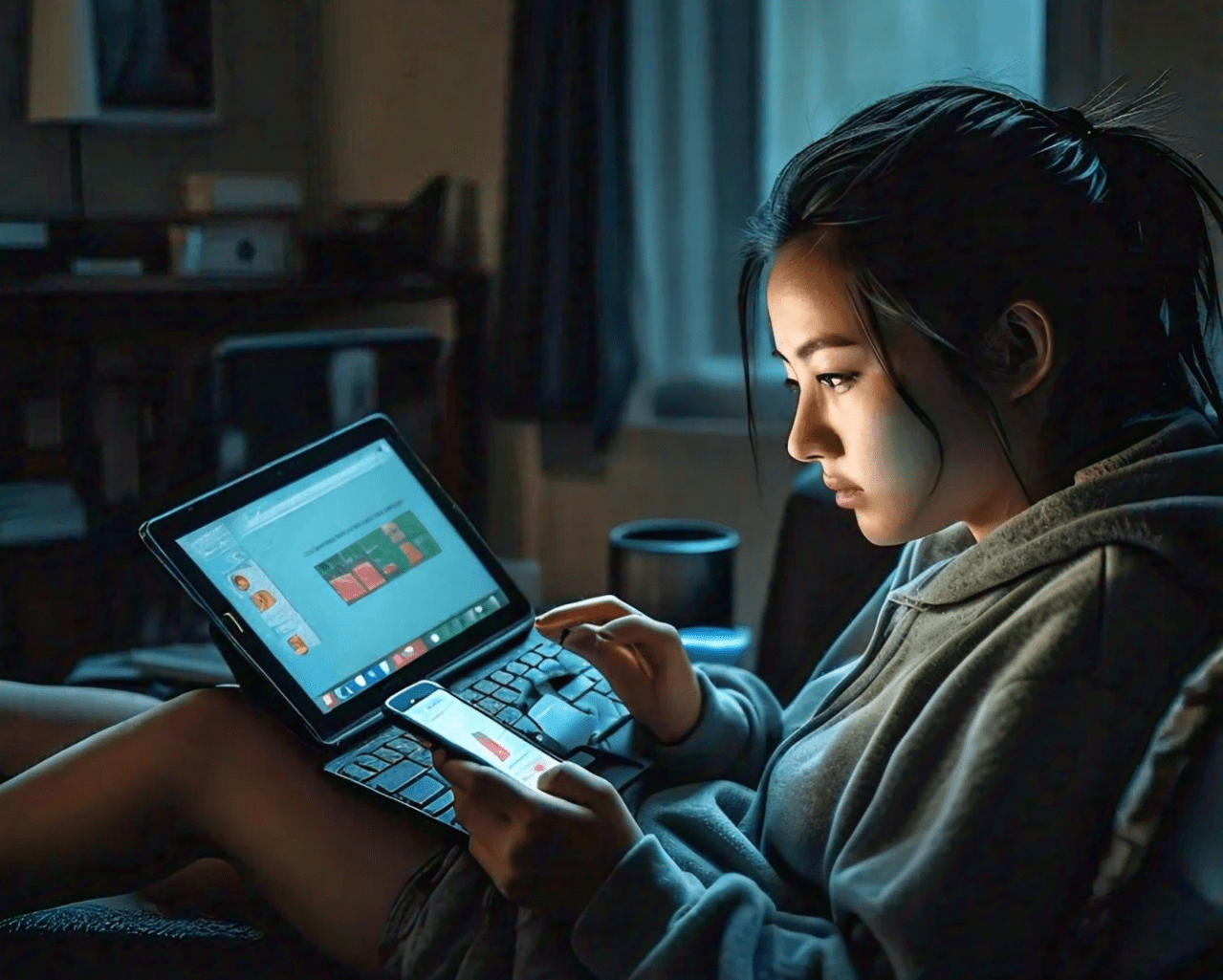In an era where digital devices dominate our daily lives, managing screen time has become a crucial aspect of maintaining a healthy and balanced lifestyle. From work and education to entertainment and social interactions, screens are integral to modern living. However, excessive screen time can have significant implications for our physical and mental well-being. In this comprehensive guide, we will explore the importance of screen time management, delve into the tools available to monitor and control screen usage, and provide actionable tips to help you and your family achieve a healthier relationship with technology.

Understanding Screen Time
Screen time refers to the amount of time spent using devices with screens, such as smartphones, tablets, computers, and televisions. It encompasses various activities, including watching videos, browsing the internet, using social media, gaming, and working on digital platforms. While screen time is an inevitable part of modern life, especially with the rise of remote work and digital education, it is essential to understand the potential effects of excessive screen usage.
The Impact of Excessive Screen Time
Excessive screen time can lead to several physical and mental health issues. One of the most common physical problems associated with prolonged screen time is digital eye strain, also known as computer vision syndrome. Symptoms of digital eye strain include dry eyes, blurred vision, headaches, and neck and shoulder pain. The blue light emitted by screens can also interfere with sleep patterns, leading to insomnia and poor sleep quality.
Beyond physical health, excessive screen time can have psychological implications. Studies have shown that spending too much time on screens, particularly on social media, can contribute to feelings of anxiety, depression, and loneliness. The constant exposure to curated images and content on social media can lead to unrealistic comparisons and a distorted sense of self-worth. Additionally, excessive screen time can reduce the amount of time spent on physical activities, leading to a sedentary lifestyle, which is linked to various health issues such as obesity and cardiovascular diseases.
For children and adolescents, the impact of screen time is even more pronounced. Excessive screen time during the formative years can affect cognitive development, attention span, and academic performance. It can also lead to behavioral issues, such as aggression and hyperactivity, and disrupt sleep patterns, which are crucial for growth and development. Given these potential risks, it is vital to establish healthy screen time habits for both adults and children.
Recommended Screen Time Limits
The amount of screen time considered healthy varies depending on age, purpose, and individual circumstances. While there are no strict guidelines, several organizations, including the American Academy of Pediatrics (AAP) and the World Health Organization (WHO), have provided recommendations:
- Children under 2 years: Screen time should be avoided as much as possible, except for video chatting with family members.
- Children aged 2 to 5 years: Limit screen time to one hour per day of high-quality programming.
- Children aged 6 and older: Establish consistent limits on screen time, ensuring that it does not interfere with sleep, physical activity, or other essential activities.
- Teenagers and adults: While there is no specific limit, it is advisable to minimize recreational screen time and focus on balancing screen-based activities with other aspects of life, such as exercise, social interactions, and sleep.
These guidelines emphasize the importance of moderation and balance. It is not about eliminating screen time but rather about ensuring that it is used in a way that supports overall well-being.
Tools for Monitoring and Managing Screen Time
With the increasing prevalence of digital devices, various tools and apps have been developed to help individuals and families monitor and manage their screen time. These tools provide insights into how much time is spent on different activities and allow users to set limits and create healthier digital habits. Here are some of the most effective tools for managing screen time:
Built-In Screen Time Features on Smartphones: Most smartphones come with built-in screen time management features that allow users to track their usage and set limits. For example, iPhones have a Screen Time feature that provides detailed reports on how much time is spent on different apps and activities. It also allows users to set daily limits for specific apps, schedule downtime, and restrict access to certain content. Similarly, Android devices offer Digital Wellbeing tools that provide insights into screen usage and offer features like Focus Mode and App Timers to help users manage their time more effectively.
Parental Control Apps: For parents looking to manage their children’s screen time, parental control apps are invaluable tools. These apps allow parents to monitor their children’s device usage, set screen time limits, and block access to inappropriate content. Some popular parental control apps include:
- Family Link: Developed by Google, Family Link allows parents to set daily screen time limits, approve or block app downloads, and monitor their child’s activity on Android devices.
- Norton Family: Norton Family offers comprehensive parental control features, including time limits, web filtering, and location tracking, to help parents manage their child’s screen time and online safety.
- Qustodio: Qustodio provides detailed reports on screen time usage, app activity, and web searches, along with the ability to set time limits and block specific apps or websites.
Time Management Apps: In addition to built-in features, several third-party apps are designed to help users manage their screen time more effectively. These apps offer a range of features, from tracking screen time to setting goals and blocking distracting apps. Some popular time management apps include:
- RescueTime: RescueTime runs in the background on your devices and tracks how much time you spend on different apps and websites. It provides detailed reports on your productivity and allows you to set goals and receive alerts when you exceed your screen time limits.
- Moment: Moment tracks your screen time on iPhone and iPad, providing insights into your usage patterns. It also offers coaching programs to help you reduce your screen time and develop healthier habits.
- Forest: Forest is a unique app that encourages you to stay focused by planting virtual trees. When you want to concentrate on a task, you plant a tree in the app, and it grows as long as you stay off your phone. If you leave the app, the tree dies, motivating you to stay focused.
Screen Time Management Software for Computers: For those who spend a significant amount of time on computers, screen time management software can be a useful tool to track and limit usage. Some popular options include:
- Freedom: Freedom is a productivity app that blocks distracting websites and apps across all your devices. It allows you to create custom blocklists, schedule sessions, and set time limits to help you stay focused.
- Cold Turkey: Cold Turkey is a free productivity tool that blocks access to specific websites, apps, and even the entire internet during set times. It is particularly useful for individuals who struggle with procrastination or need to limit their screen time for work or study purposes.
Stay Focused: Stay Focused is a browser extension for Google Chrome that helps you stay focused by limiting the amount of time you can spend on distracting websites. Once your allotted time is up, the extension blocks access to those sites for the rest of the day.
- Wearable Devices: Wearable devices, such as smartwatches and fitness trackers, can also play a role in managing screen time. These devices often come with features that monitor your physical activity, sleep patterns, and overall well-being. By providing reminders to move, take breaks, and prioritize sleep, wearable devices can help you balance your screen time with other aspects of your health.
- Digital Wellbeing Platforms: Several tech companies have developed digital wellbeing platforms to help users manage their screen time and promote healthier digital habits. For example:
-
- Google Digital Wellbeing: Google’s Digital Wellbeing platform is integrated into Android devices and offers features like Wind Down, which reduces screen brightness and converts the display to grayscale in the evening to help you wind down for bed. It also includes Focus Mode, which temporarily pauses distracting apps, and app usage data to help you understand and manage your screen time.
-
- Apple Screen Time: Apple’s Screen Time feature, available on iOS devices, provides detailed insights into your screen usage, allowing you to see how much time you spend on different apps and activities. It also offers tools to set limits, schedule downtime, and manage your child’s device usage through Family Sharing.
-
- Microsoft Family Safety: Microsoft’s Family Safety app allows parents to monitor their children’s screen time, set limits, and receive activity reports. It also offers location tracking and driving safety features to promote safe digital and physical habits.
Best Practices for Managing Screen Time
While tools and apps can help you monitor and control your screen time, developing healthy habits and best practices is essential for long-term success. Here are some practical tips to help you and your family manage screen time effectively:
- Set Clear Limits: Establishing clear and realistic screen time limits is one of the most effective ways to manage your digital usage. Determine how much time you and your family should spend on screens each day, taking into account work, school, and recreational activities. Use built-in features or third-party apps to enforce these limits and ensure that everyone adheres to them.
- Create Screen-Free Zones: Designating certain areas of your home as screen-free zones can help reduce screen time and encourage other activities. For example, you might establish the dining room as a screen-free zone, where meals are enjoyed without the distraction of phones, tablets, or TVs. Similarly, consider making bedrooms screen-free to promote better sleep hygiene.
- Incorporate Screen-Free Activities: Balance your screen time with screen-free activities that promote physical and mental well-being. Encourage outdoor play, exercise, reading, and creative hobbies that do not involve screens. Engaging in these activities can help reduce reliance on digital devices and foster a more balanced lifestyle.
- Prioritize Sleep: Sleep is a critical aspect of health, and screens can significantly impact sleep quality. To promote better sleep, avoid using screens at least an hour before bedtime. The blue light emitted by screens can interfere with the production of melatonin, a hormone that regulates sleep. Consider using blue light filters or wearing blue light-blocking glasses in the evening to reduce the impact on your sleep.
- Be a Role Model: Children often mimic the behavior of their parents, so it is essential to model healthy screen time habits. Be mindful of your own screen usage, and demonstrate the importance of balancing digital and offline activities. Set a positive example by engaging in screen-free activities with your children, such as playing board games, going for walks, or cooking together.
- Use Technology Mindfully: While technology offers numerous benefits, it is important to use it mindfully. Be intentional about how you use screens, focusing on activities that add value to your life rather than mindlessly scrolling through social media or watching videos. Practice digital mindfulness by taking regular breaks, limiting multitasking, and being aware of how screen time affects your mood and well-being.
- Establish a Digital Detox Routine: Periodically taking a break from screens can help reset your relationship with technology. Consider establishing a regular digital detox routine, where you and your family disconnect from screens for a set period. This could be a few hours, a day, or even a weekend. Use this time to reconnect with nature, engage in physical activities, or spend quality time with loved ones.
- Monitor and Reflect on Screen Time Usage: Regularly review your screen time usage to identify patterns and areas where you can make improvements. Reflect on how screen time affects your physical and mental health, and make adjustments as needed. For example, if you notice that you feel more stressed or anxious after spending time on social media, consider reducing your usage or setting stricter limits on those platforms.
- Encourage Open Communication: Encourage open communication about screen time within your family. Discuss the potential benefits and drawbacks of screen usage, and work together to establish rules and boundaries that everyone can follow. Involving your children in the decision-making process can help them feel more responsible for their screen time habits and more likely to adhere to the limits set.
- Stay Informed About Digital Trends: The digital landscape is constantly evolving, with new apps, games, and platforms emerging regularly. Stay informed about digital trends and the potential risks and benefits associated with them. Understanding how different digital activities impact screen time and well-being will enable you to make informed decisions about your own and your family’s screen usage.
The Role of Screen Time in Digital Well-Being
Digital well-being is a concept that emphasizes the importance of maintaining a healthy relationship with technology. It involves using digital devices in a way that enhances your quality of life while minimizing potential harm. Managing screen time is a key component of digital well-being, as it allows you to strike a balance between the benefits and drawbacks of technology.

The pursuit of digital well-being is not about eliminating screen time but about being mindful of how and when you use screens. By understanding your screen time habits and making conscious efforts to balance your digital and offline life, you can improve your overall well-being. Whether it’s through setting limits, using parental controls, or simply being more intentional with your screen time, taking control of your digital habits is essential for a healthier, more balanced life.
Conclusion
In a world where screens are ubiquitous, managing screen time is essential for maintaining physical and mental well-being. By understanding the impact of excessive screen time and implementing strategies to manage it effectively, you can create a healthier relationship with technology. Whether you’re a parent looking to set limits for your children or an individual seeking to reduce your own screen time, the tools and tips provided in this guide can help you achieve a balanced and fulfilling digital life.
Remember, the goal is not to eliminate screen time but to use it in a way that enhances your life rather than hinders it. Start today by setting realistic limits, using the right tools, and prioritizing your digital well-being. By doing so, you’ll be well on your way to achieving a healthier, more balanced lifestyle in the digital age.



